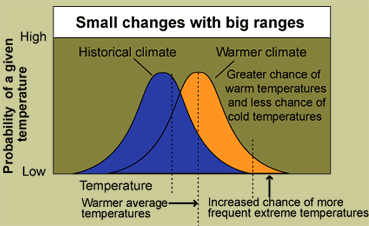| ||||||||||||||||||||||||||||
Proactive disclosure Print version |  The winds of change: Climate change in Prairie Provinces Extreme weather Changing weather patterns
As the Earth warms, it is possible that weather patterns could shift. Extreme events such as severe thunderstorms, tornadoes, hailstorms, and heat waves may become more prevalent on the Prairies. Warmer winters may increase the potential for more intense winter storms, and increase the likelihood of rainstorms. In summer, we may see intense precipitation events resulting in localized flooding. The pattern of other weather-related conditions, such as droughts, may also change. Did you know?  Did you know? The cost of weather-related disasters Weather-related disasters include droughts, blizzards, floods, heat waves, hailstorms, snow storms, thunderstorms, forest fires, and tornadoes. Recently, the Prairies have experienced more expensive disasters including the Edmonton tornado of 1987, the Calgary hailstorm of 1991, the Winnipeg flood of 1993, the Red River flood of 1997, flooding and excess moisture in southeastern Saskatchewan and southwestern Manitoba in 1999, and the Pine Lake tornado of 2000. The costs of these disasters indicates that we have become more vulnerable to extreme events. While difficult to predict, the frequency and severity of these extreme events could also increase as a result of climate change.
Did you know? The Calgary hailstorm of 1991 lasted 30 minutes and caused more than $350 million in damage to vehicles and property. References Smit, B., Burton, I., Klein, R.J.T., and Wandel, J., in press: An anatomy of adaptation to climate change and variability; Climate Change.
|